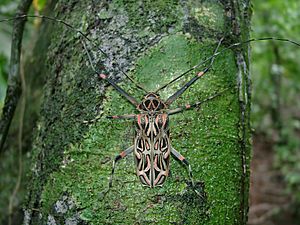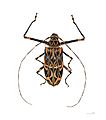Harlequin beetle facts for kids
Quick facts for kids Harlequin beetle |
|
|---|---|
 |
|
| The beetle in its habitat | |
 |
|
| Scientific classification | |
| Synonyms | |
|
|
The harlequin beetle (Acrocinus longimanus) is a large, colorful insect. It is a type of longhorn beetle. You can find it in warm, tropical areas. These areas stretch from southern Mexico all the way to Uruguay.
This beetle gets its name from its bright, fancy patterns. It has black, red, and greenish-yellow spots. These markings are on its wing covers. Both male and female beetles have these patterns. The name longimanus comes from Latin. It means "long hands" or "long forelegs." This is because the male beetles have very long front legs. These legs can be longer than the beetle's whole body! Adult harlequin beetles can grow to be about 76 mm (3 inches) long. They are also known for carrying tiny creatures called pseudoscorpions on their bodies. This is a special kind of hitchhiking.
Male and Female Differences
Harlequin beetles show clear differences between males and females. This is called sexual dimorphism.
- Male forelegs: The male's front legs are much longer than the female's. They can also be quite curved in larger males.
- Fighting for spots: Males use their long front legs to fight each other. They try to flip other males off dead or dying trees.
- Egg laying: Females choose these trees to lay their eggs. The larvae (baby beetles) will then have food to eat.
Special Abilities
Scientists have found special substances in the harlequin beetle. These are called peptides. One of these, named Alo-3, is very interesting.
- Fighting germs: Alo-3 can help fight against certain types of fungi. One example is a fungus called Candida glabrata.
- Future medicine: Researchers are studying these peptides. They hope to find new ways to treat serious infections in humans. These infections can be hard to treat right now.
Images for kids
See also
 In Spanish: Aserrador arlequín para niños
In Spanish: Aserrador arlequín para niños




